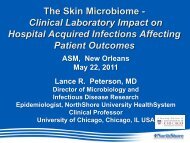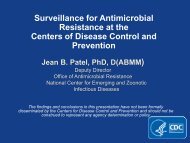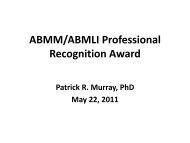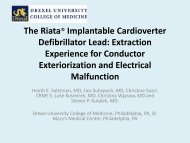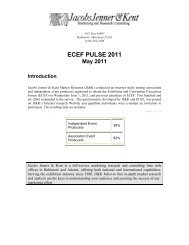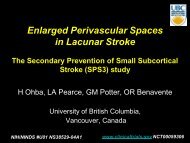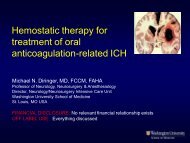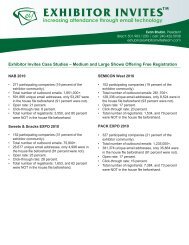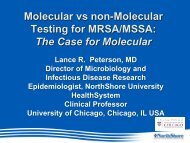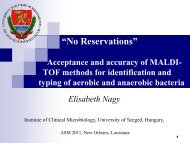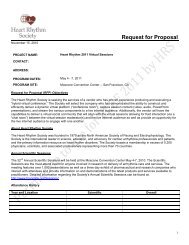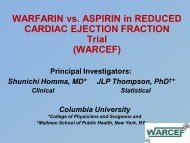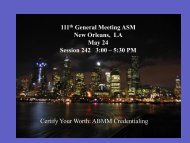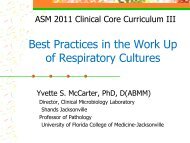Reversible Cerebral Vasoconstriction Syndromes (RCVS)
Reversible Cerebral Vasoconstriction Syndromes (RCVS)
Reversible Cerebral Vasoconstriction Syndromes (RCVS)
Create successful ePaper yourself
Turn your PDF publications into a flip-book with our unique Google optimized e-Paper software.
<strong>Reversible</strong> <strong>Cerebral</strong> <strong>Vasoconstriction</strong><br />
<strong>Syndromes</strong> (<strong>RCVS</strong>)<br />
Aneesh B. Singhal, M.D.<br />
Associate Professor of Neurology<br />
Harvard Medical School<br />
Stroke Service, Mass. General Hospital
<strong>Cerebral</strong> Arteriopathies<br />
• Cause stroke and vascular headache<br />
• Overall, the most common cause of stroke<br />
– 20% to 50% in older adults (LAA and SVD)<br />
– 30% to 40% in young adults<br />
– > 50% in children<br />
[1] Baltimore-Washington Cooperative Young Stroke Study.<br />
[2] Helsinki Young Stroke Registry.<br />
[3] International Pediatric Stroke Study.<br />
[4] Wong LK. Global burden of intracranial atherosclerosis. Int J Stroke. 2006
Patients (mostly women): rTCH ± stroke/seizure<br />
A<br />
D<br />
B C<br />
E<br />
? PACNS CSF, vasculitis labs, brain biopsy negative<br />
Some treated with empiric steroids / cyclophosphamide<br />
F
Nomenclature: 1960s – 2000s<br />
• Call or Call-Fleming syndrome<br />
• Postpartum angiopathy<br />
• Eclampsia associated vasoconstriction<br />
• Migraine ‘angiitis’<br />
• Thunderclap HA with reversible ‘vasospasm’<br />
• Drug induced ‘angiitis’<br />
• CNS ‘pseudovasculitis’<br />
• Benign angiopathy of the CNS (BACNS)<br />
‘<strong>RCVS</strong>’ includes all of the above
Key Elements for Diagnosis<br />
1. Severe, acute, recurrent ‘thunderclap’<br />
headache with or without additional neurologic<br />
signs or symptoms<br />
2. DSA / CTA/ MRA : multifocal vasoconstriction<br />
3. No evidence for aneurysmal SAH<br />
4. Normal CSF (protein
MGH and Cleveland Clinic Data
Characteristic<br />
Clinical Features<br />
CCF<br />
(n=55)<br />
MGH<br />
(n=84)<br />
Mean age (yrs) 43 +/- 11 42+/-12 0.65<br />
Female 80% 82% 0.75<br />
Caucasian 76% 82% 0.52<br />
Associated Trigger<br />
(?)<br />
Postpartum 4% 12% 0.12<br />
Idiopathic 45% 29% 0.042*<br />
Drugs 36% 61% 0.005*<br />
Migraine 24% 50% 0.002*<br />
P
Characteristic<br />
Clinical Features<br />
CCF<br />
(n=55)<br />
MGH<br />
(n=84)<br />
Any HA at onset 95% 95% 0.99<br />
Thunderclap 84% 86% 0.99<br />
Recurrent TCH 74% 87% 0.06<br />
Focal deficits 38% 46% 0.34<br />
Onset seizures 16% 18% 0.82<br />
Presented
Laboratory and Imaging Features<br />
Characteristic<br />
CCF<br />
(n=55)<br />
MGH<br />
(n=84)<br />
CSF performed 80% 77% 0.71<br />
CSF protein
Characteristic<br />
Brain Imaging<br />
CCF<br />
(n=55)<br />
MGH<br />
(n=84)<br />
First CT or MRI normal 57% 55% 0.83<br />
Any CT / MRI abnormal 79% 73% ns<br />
Lesion Patterns<br />
Cortical surface SAH 23% 42% 0.022*<br />
Ischemic stroke 38% 40% 0.75<br />
Lobar hemorrhage 23% 18% 0.49<br />
P
Characteristic<br />
Follow-up Imaging<br />
CCF<br />
(n=55)<br />
MGH<br />
(n=84)<br />
F/up CTA, MRA, DSA 60% 70% 0.21<br />
F/up TCD only 35% 30% 0.55<br />
Full Reversibility 76% 73% 0.69<br />
Partial Reversibility 21% 26% 0.61<br />
No Reversibility 2.4% 1.5% 0.99<br />
Median F/up (days) 66<br />
(27,152)<br />
56<br />
(30,94)<br />
P<br />
0.35
<strong>Cerebral</strong> Angiography<br />
‘beading’<br />
‘sausage-on-a-string’<br />
<strong>RCVS</strong>: Brain Imaging<br />
Diffusion-MRI<br />
symmetric infarcts<br />
watershed regions<br />
FLAIR-MRI<br />
vasogenic edema<br />
(posterior leukoencephalopathy<br />
)
<strong>RCVS</strong>: Brain Imaging
RCV, RPLS, ICH, ICA-dissection
Brain Hemorrhage in <strong>RCVS</strong><br />
Hemorrhages are common, more so in women, and<br />
frequently assoc. with vasoconstrictive drugs<br />
Types<br />
1. Small non-aneurysmal cortical surface SAH<br />
2. Parenchymal ICH – lobar (single or multiple)<br />
3. Subdural hemorrhage<br />
CT and FLAIR<br />
Cortical SAH<br />
GRE-MRI<br />
Cortical SAH<br />
CT<br />
Lobar ICH<br />
GRE-MRI<br />
Cerebellar ICH
Pathophysiology<br />
TCH<br />
<strong>RCVS</strong><br />
PRES<br />
overlapping clinical, imaging features…<br />
?shared pathophysiology<br />
endothelium, perivascular nerves, serotonin, epinephrine
• Migraine<br />
Differential Diagnosis<br />
• Thunderclap headache (TCH)<br />
– aneurysmal SAH, intracerebral hemorrhage,<br />
CVST, pituitary apoplexy, viral encephalitis,<br />
vertebral or carotid dissection, PCA embolus<br />
• Similar angiographic abnormalities<br />
– Primary angiitis of the CNS (PACNS)<br />
– Moyamoya disease<br />
– FMD<br />
– Intracranial atherosclerosis
Distinguishing <strong>RCVS</strong> from PACNS<br />
Feature <strong>RCVS</strong> PACNS<br />
Headache Recurrent TCH Insidious, chronic<br />
Infarct pattern ‘Watershed’ Small, scattered<br />
Lobar H’rrge Common Rare<br />
Cortical SAH Common Rare<br />
<strong>Reversible</strong> edema Common -<br />
Angiogram Sausage on a<br />
string (smooth)<br />
Irregular, notched,<br />
ectasia
Diagnostic Approach<br />
1. Clinical Recognition (rTCH)<br />
2. Brain Imaging (lesion patterns)<br />
3. Angiography (‘sausage-string’)<br />
<strong>RCVS</strong>: an “instantly recognizable” condition
<strong>RCVS</strong> Treatment Options<br />
1. Simple observation !!<br />
2. IV fluids, pain management, laxatives<br />
3. Avoid precipitants e.g. vasoconstrictive drugs<br />
4. Avoid blood pressure modulation<br />
5. Ca ++ channel blockers (nimodipine, verapamil, Mg)<br />
6. Short course of steroids (best avoided!!)<br />
7. Fulminant cases: balloon angioplasty, IA nicardipine
Characteristic<br />
Treatment and Outcomes<br />
CCF<br />
(n=55)<br />
MGH<br />
(n=84)<br />
Ca Channel Blockers 87% 46%
Regression: predictors of poor outcome<br />
Factor All Patients<br />
P Value<br />
MGH Cohort<br />
P Value<br />
Age 0.61 0.95<br />
Female 0.87 0.74<br />
CaCB 0.27 0.98<br />
Steroids 0.09 < 0.001<br />
MGH of 23 patients who received steroids, 11<br />
(48%) had new symptoms and new infarcts<br />
within 2-6 days after steroid initiation
CTA before IA treatment (PPD 20)<br />
Singhal et al., New Eng J Med 2009
CTA after IA treatment<br />
Singhal et al., New Eng J Med 2009
Final MRI 6 Days After Admission<br />
Singhal et al., New Eng J Med 2009
Autopsy: no evidence for inflammation<br />
Distal left MCA
<strong>RCVS</strong><br />
• Group of conditions characterized by reversible<br />
segmental constriction-dilatation of cerebral arteries<br />
• ~90% have recurrent ‘thunderclap’ headaches<br />
• Brain MRI can be normal or show ischemic stroke,<br />
ICH, cSAH, or reversible brain edema (PRES)<br />
• Usually a self-limited condition with benign outcome<br />
• Angiographic reversal occurs within days to weeks<br />
• Pathophysiology: ?abnormal cerebral vascular tone<br />
Singhal et al., Arch Neurol 2011; Calabrese et al., Ann Int Med 2007;<br />
Ducros et al., Brain 2007; Chen et al., Ann Neurol 2008, 2010
Next Steps<br />
International Collaboration<br />
Validate provisional diagnostic criteria<br />
Define relationships with PRES and TCH<br />
Clarify whether drugs can precipitate <strong>RCVS</strong><br />
Pathophysiology – biomarkers, autoregulation<br />
Investigate treatments e.g. nimodipine<br />
What’s first, headache or vasoconstriction?<br />
Why ‘segmental’? Why prolonged?
Stroke attributed to<br />
‘vasospasm’ for centuries<br />
1950s: Pathological entities<br />
- Carotid athero<br />
- Atrial fibrillation<br />
- Lacunar<br />
‘Vasospasm’ not implicated<br />
- except SAH<br />
- except rare migraine<br />
1971, 1975: Salpetrierre Conf.<br />
1988: Call-Fleming Syndrome<br />
C. Miller Fisher, MD
M. Akif Topcuoglu, MD (circa 2002)
Hemorrhages in 1 st week, Infarcts in 2 nd week
Additional Slides<br />
- Pathophysiology<br />
(BHI, endothelium/p-v nerves, drugs)<br />
- Migraine vs. <strong>RCVS</strong><br />
- <strong>RCVS</strong> vs. PACS
Pathophysiology
Pathophysiology of <strong>RCVS</strong><br />
- ‘migrainous vasospasm’<br />
- ‘mechanical’: catheter-induced vasospasm<br />
- ‘angiographic dye’ - bradykinin<br />
- sympathomimetic (ergot, amphetamine, cocaine)<br />
- endothelin-1, nitric oxide, substance P, CGRP<br />
- female reproductive hormones<br />
- serotonin<br />
- calcium
A B<br />
C<br />
(A) Headframe used for bedside TCD examination.<br />
Breath Holding Index<br />
%(V apnea-V baseline)<br />
V baseline x t apnea<br />
Normal = 1.2 ± 0.6<br />
(B) Representative CT-angiogram showing multifocal segmental stenosis<br />
(“beading”) of the bilateral middle cerebral arteries, basilar, posterior<br />
cerebral, and superior cerebellar arteries.<br />
(C) TCD spectrum showing elevated mean flow velocity in the left MCA.
TCD response to Apnea (breath-hold)<br />
Percentage Change of CBFV (%)<br />
20<br />
15<br />
10<br />
5<br />
0<br />
-5<br />
-10<br />
-15<br />
-20<br />
Control Migraine <strong>RCVS</strong><br />
BH start Min BH end
Perivascular nerves<br />
smooth muscle cells<br />
endothelial cells
Perivascular Nerves<br />
• Perivascular nerves release various<br />
neurotransmitters and peptides, including 5-HT (Reinhard<br />
et al., Science, 1979, 206: 85)<br />
• Perivascular nerves contain catecholamines, but<br />
vasoconstriction from norepinephrine is poor across<br />
species, including humans (Bevan et al., Stroke, 1998, 29: 212.)<br />
• Interestingly, perivascular sympathetic nerves take<br />
up serotonin both in vitro and during the early phase<br />
of subarachnoid hemorrhage (Szabo et al., Stroke, 1992, 23: 54.)
Endothelium<br />
• Modulates vascular caliber by producing and<br />
releasing EDRFs such as NO, PGI2, EDHF<br />
• Cerebrovascular endothelial dysfunction might<br />
be related to vasoconstriction in <strong>RCVS</strong>-PRES?<br />
• Increased plasma levels of soluble antiangiogenic<br />
factors (sFlt1, endoglin) documented<br />
in pre-eclampsia and may underlie the<br />
endothelium dysfunction.<br />
(Levin et al. NEJM 2004, 2006; Singhal et al, NEJM 2009)
Hypothesis<br />
• Raphe nuclei in the brainstem, projections to<br />
peri-vascular nerves<br />
– trigeminovascular system and serotonergic pathways<br />
• Increased serotonin, NE levels in nerve endings<br />
• Might explain the headache, hyper-reflexia,<br />
segmental vasoconstriction, depression in <strong>RCVS</strong><br />
• Distal capillary bed - serotonergic effects may<br />
explain edema, overlap with PRES<br />
• In addition, endothelial dysfunction might be<br />
related to vasoconstriction in <strong>RCVS</strong>-PRES?<br />
– soluble anti-angiogenic factors (sFlt1, endoglin)<br />
• (Levin et al. NEJM 2004, 2006; Singhal et al, NEJM 2009)
Spectrum - disorders of cerebrovascular tone?<br />
Headache, vasoconstriction-vasodilatation<br />
Stroke<br />
Ischemic<br />
ICH<br />
cSAH<br />
Dissection<br />
TCH<br />
Other 1° Headaches<br />
Hypertensive enceph.<br />
Eclampsia<br />
Porphyria<br />
Head trauma<br />
Post-CEA<br />
Sympathomimetic drugs<br />
Serotonergic drugs<br />
- etc -<br />
Edema<br />
(PRES)
Inter-relationship between <strong>RCVS</strong> & PRES<br />
4 postpartum patients with RCV & PRES<br />
A<br />
B<br />
C D D<br />
Singhal AB, Arch Neurol 2004;61:411-6<br />
b<br />
A<br />
B<br />
C
<strong>RCVS</strong> and Drugs/Meds<br />
Ergot derivatives (bromocryptine, ergotamine, lisuride)<br />
Nasal decongestants (ephedrine, phenylpropanolamine)<br />
Diet pills (metabolife, ephedra supplements, ma huang)<br />
Cocaine, amphetamines, LSD, marijuana<br />
Cyclosporin A<br />
Erythropoetin, RBC transfusion, Hypercalcemia<br />
Licorice<br />
Intravenous immune globulin<br />
Sumatriptan<br />
SSRIs, in combination with other vasoactive drugs<br />
Hormonal – OCPs
<strong>RCVS</strong> and serotonergic drugs<br />
Drugs and ICH: epidemiological studies controversial<br />
•Hemorrhagic Stroke Project: PPA in diet pills, ephedra<br />
• Korean Study: PPA in cold remedies<br />
• Mexican study: sympathomimetics<br />
Association of drugs with <strong>RCVS</strong> remains anecdotal
Serotonin – central role in <strong>RCVS</strong>?<br />
Sumatriptan: 5-HT 1B,D receptors<br />
Cocaine, amphetamines: sympathomimetic + serotonergic actions<br />
Diet pills: stroke, “carcinoid” heart & lung lesions (NEJM 1997)<br />
Subarachnoid hemorrhage: ? neuronal serotonin uptake/release<br />
Migraine related stroke: ?serotonergic mechanisms<br />
Head injury: ? release of serotonin from brain, platelets<br />
Porphyria: liver tryptophan pyrrolase is haem-dependant; haem<br />
deficiency in porphyria elevates 5-HT levels (Nature 1983)<br />
Serotonin Syndrome: assoc. with migrainous stroke (Headache 1997)
Serotonin – further evidence<br />
• SSRIs associated with digit ischemia<br />
• serotonin implicated in Raynaud’s phenomenon<br />
• sumatriptan and Prinzmetal’s angina, MI<br />
• sumatriptan and mesenteric ischemia<br />
• Diet pills: sympathomimetic + serotonergic<br />
effects, reversible cardiac valvular lesions and<br />
pulmonary hypertension (carcinoid syndrome)<br />
• Abilify and stroke
Serotonergic meds common…but<br />
<strong>RCVS</strong> is relatively uncommon<br />
Idiosyncratic reaction?<br />
Transient effect?<br />
‘Tip of the iceberg’?<br />
Genetic polymorphisms?<br />
Genetic variation of SERT<br />
Genetic variation of 5-HT receptors<br />
Genetic variation affecting other regulatory proteins
<strong>RCVS</strong> and Migraine
<strong>RCVS</strong> and Migraine<br />
Is <strong>RCVS</strong> simply a severe migraine attack?<br />
Several differences between migraine and <strong>RCVS</strong>…<br />
- Migraine has vascular and neuronal basis<br />
- Angiogram in migraine invariably normal<br />
- Migraine is a primary headache disorder; while<br />
headache in <strong>RCVS</strong> may be ‘symptomatic’<br />
- Migraine recurs for years, <strong>RCVS</strong> rarely recurs<br />
- Only 25% of pts with <strong>RCVS</strong> have prior migraine<br />
Singhal AB, Neurology 2002
Other Headaches and ‘Vasospasm’<br />
IHS classification v.2: ‘Other Primary Headaches’<br />
4.1 Primary stabbing headache<br />
4.2 Primary cough headache<br />
4.3 Primary exertional headache<br />
4.4 Primary headache associated with sexual activity<br />
4.5 Hypnic headache<br />
4.6 Primary thunderclap headache<br />
4.7 Hemicrania continua<br />
4.8 New persistent daily headache
Neurology 2006: 67:2164<br />
• Prospectively recruited 56 patients with<br />
recurrent TCH of unknown etiology<br />
• MR-angiography in all; repeated if abnormal<br />
• <strong>RCVS</strong> in 39% [MCA 100%, ACA, PCA ~50%, basilar 9%]<br />
• Ischemic stroke in 7% (14% Pv, 3% Pn)<br />
• Pv and Pn showed no difference in<br />
demographics and headache characteristics<br />
except for higher rate of Valsalva-like triggers<br />
(exertion, defecation)
<strong>RCVS</strong> vs. aSAH
<strong>RCVS</strong>-SAH (n=35) vs. aSAH (n=515)<br />
• Univariate analysis:<br />
younger (43±12 vs. 55±14 years; p
<strong>RCVS</strong> (n=35) vs. aSAH (n=515)<br />
• <strong>RCVS</strong><br />
– Acute and multi-focal vasoconstriction<br />
– Small, cortical surface bleeds<br />
– Early infarcts, parenchymal bleeds, RPLS<br />
– Associated condition: pregnancy, drugs<br />
• Vasospasm in aSAH<br />
– Usually delayed, and affects 1-2 arteries<br />
– TCH not recurrent<br />
– Delayed infarction<br />
– Evidence for ruptured aneurysm<br />
Muelschlagel & Singhal, ISC 2011
<strong>RCVS</strong> vs. PACNS
<strong>RCVS</strong> versus PACNS<br />
• 1950s: Primary angiitis of the CNS (PACNS)<br />
uniformly poor outcome; requires prompt<br />
immunosuppressive therapy<br />
• Until late 2000s: <strong>RCVS</strong> under-recognized<br />
(variable nomenclature - Call’s, BACNS, PPA,<br />
vasospasm in eclampsia, TCH, migraine, drugs)<br />
• 1950s-2000s: patients with <strong>RCVS</strong> misinterpreted<br />
as having PACNS due to overlapping features<br />
such as headache, cerebral angiographic<br />
abnormalities, and ischemic stroke<br />
patients with <strong>RCVS</strong> exposed to the risks of brain<br />
biopsy, chronic immunosuppressive therapy
Angio positive in 70 cases; biopsy positive in 31 cases<br />
18 patients with positive angio, negative biopsy
<strong>RCVS</strong> vs PACNS: MGH cases, 1993-2009<br />
Clinical Characteristic <strong>RCVS</strong><br />
(n=84)<br />
PACNS<br />
(n=35)<br />
P value<br />
Age in years, Mean ± SD 42 ± 12 49 ± 16 0.02<br />
Female 82% 31% < 0.001<br />
Depression or Anxiety 38% 11% 0.004<br />
Prior Chronic Migraine 43% 14% 0.003<br />
Thunderclap Headache (TCH) at<br />
Onset<br />
Associated Condition<br />
• No identifiable factor<br />
• Miscellaneous<br />
• Postpartum<br />
• Vasoactive drugs<br />
SSRI<br />
Illicit drugs<br />
Imitrex<br />
Sympathomimetics<br />
86% 6%
<strong>RCVS</strong> vs PACNS: MGH cases, 1993-2009<br />
Characteristic <strong>RCVS</strong><br />
(n=84)<br />
PACNS<br />
(n=35)<br />
P value<br />
Hemiplegia or aphasia 32% 51% n.s.<br />
Hemianopia / cortical blindness 41% 26% n.s.<br />
Seizures 18% 17% n.s.<br />
Hypertensive (≥140, ≥ 90mmHg) 45% 32% n.s.<br />
ESR, mm/ hour, mean (SD) 23 (22) 31 (23) n.s.<br />
CSF results abnormal<br />
WBC (corrected for RBC)<br />
Protein (mean, SD)<br />
Pathology available<br />
Positive histology<br />
24%<br />
2.5 (3.5)<br />
50 (43)<br />
13%<br />
0%<br />
70%<br />
19.5 (28.4)<br />
86 (124)<br />
77%<br />
33%<br />
<strong>RCVS</strong> vs PACNS: MGH cases, 1993-2009<br />
Brain Imaging<br />
Initial Brain MRI Results<br />
Normal scan<br />
Infarct<br />
Parenchymal hemorrhage*<br />
Subarachnoid hemorrhage*<br />
RPLS<br />
Mass lesion<br />
New Lesion on F/up (n=76)<br />
New lesion present<br />
Infarct<br />
Parenchymal hemorrhage<br />
Subarachnoid hemorrhage<br />
RPLS<br />
<strong>RCVS</strong><br />
(n=84)<br />
20%<br />
33%<br />
14%<br />
35%<br />
34%<br />
0%<br />
39%<br />
26%<br />
7%<br />
13%<br />
11%<br />
PACNS<br />
(n=35)<br />
0%<br />
91%<br />
3%<br />
3%<br />
0%<br />
6%<br />
40%<br />
40%<br />
3%<br />
0%<br />
0%<br />
P value<br />
0.006<br />
<strong>RCVS</strong> vs PACNS: MGH cases, 1993-2009<br />
Brain Imaging <strong>RCVS</strong><br />
(n=84)<br />
Lesion Pattern<br />
Single<br />
Symmetric<br />
Borderzone/watershed<br />
Hemispheric lesions<br />
Superficial<br />
Deep<br />
Brainstem<br />
Cerebellum<br />
‘Dot’ sign on FLAIR<br />
33%<br />
45%<br />
83%<br />
86%<br />
55%<br />
0%<br />
24%<br />
70%<br />
PACNS<br />
(n=35)<br />
3%<br />
18%<br />
9%<br />
27%<br />
97%<br />
97%<br />
18%<br />
21%<br />
P value<br />
0.001<br />
0.03<br />
Brain Lesion Topography in <strong>RCVS</strong><br />
1. No parenchymal lesion<br />
All had recurrent<br />
‘thunderclap’ headaches<br />
(Ducros: MRI normal in 70%)<br />
2. <strong>Reversible</strong> brain edema:<br />
FLAIR-positive, ADCnegative,posteriorpredominant,<br />
grey-white<br />
matter lesions (i.e.<br />
‘reversible posterior<br />
leukoencephalopathy<br />
syndrome’)
Brain lesion topography in <strong>RCVS</strong><br />
3. MCA/PCA/ACA watershed infarcts
Lesion patterns in PACNS<br />
1. Punctate, widely distributed infarcts; deep plus superficial regions
Lesion patterns in PACNS<br />
2. Diffuse, symmetric subcortical<br />
white matter hyperintensities<br />
with additional discrete infarcts
Lesion patterns in PACNS<br />
3. Single, hyperintense, mass lesion<br />
(one patient, normal angiogram, positive pathology)<br />
Molloy, Calabrese & Singhal; Arth Rheum 2008<br />
Note: In the MGH series, PACNS was never associated with<br />
normal MRI scans. ICH was rare. It is likely that literature<br />
reports of PACNS are confounded by <strong>RCVS</strong>.
Distinguishing <strong>RCVS</strong> from PACNS<br />
Clinical differences can be ‘diagnostic’<br />
symptom onset acute in RCV, insidious in vasculitis<br />
Clinical distinction can be difficult especially in the<br />
acute stages (i.e., before the tempo of the disease<br />
is established, and without serial vascular imaging).<br />
Neuroimaging (lesion topography) may be helpful,<br />
but should be used in conjunction with the clinical<br />
features and lab. results to discriminate between<br />
these conditions.
Comparison of CTA and DSA Findings
Advanced MRI for <strong>Cerebral</strong> Arteriopathy?<br />
• Küker W et al., Vessel wall contrast enhancement: a diagnostic sign of<br />
cerebral vasculitis. Cerebrovasc Dis. 2008;26(1):23-9.<br />
• Swartz RH et al., Intracranial arterial wall imaging using high-resolution<br />
3-tesla contrast-enhanced MRI. Neurology. 2009;72(7):627-34.
A B C<br />
D<br />
E<br />
Brain biopsy positive PACNS immunosuppression<br />
F
To study the phenomena of disease<br />
without books is to sail an uncharted<br />
sea, while to study books without<br />
patients is not to go to sea at all<br />
The value of experience is not in<br />
seeing much, but in seeing wisely<br />
-Osler
<strong>Cerebral</strong> Arteriopathies<br />
1. Large or Medium-Sized Arteries<br />
a. Atherosclerosis<br />
b. <strong>Cerebral</strong> artery dissection<br />
c. <strong>Reversible</strong> cerebral vasoconstriction syndromes<br />
d. Genetic or Inherited: Moyamoya, Sickle, Fabry’s, FMD<br />
e. Inflammatory: Takayasu, Anti-phospholipid antibody-associated<br />
f. Infectious: TB, Herpes zoster, syphilis, bacterial, HIV<br />
2. Small Vessel Disease<br />
a. Inflammatory: PACNS, Giant-cell, Amyloid, PAN, SLE, Behcet’s,<br />
Scleroderma, Churg-Strauss, Degos’, Eale’s, Susac, Spatz-Lindenbergh<br />
b. Infectious: Herpes zoster, Cysticercosis<br />
c. Genetic or Inherited: CADASIL, HERNS, COL4A1 mutation
Illustrative Case<br />
46 year male: acute, 10/10 post coital headache<br />
CT-A : MCA, PCA, SCA, PICA, basilar ‘beading’<br />
Vasculitis labs negative, CSF normal (no SAH, 0 WBC)
Illustrative Case<br />
Recurrent 10/10 ‘thunderclap’ headaches<br />
Developed cortical blindness<br />
MRI: symmetric MCA and PCA ‘watershed’ infarcts<br />
DWI ADC FLAIR
Illustrative Case<br />
MR angio - severe multifocal vasoconstriction<br />
TCDs - diffusely elevated blood flow velocities<br />
3 weeks later:<br />
Deficits resolve; TCD velocities normalize<br />
MRA shows resolution of vasoconstriction.
Illustrative Case # 2<br />
57 y woman. Recurrent TCH while bathing.<br />
A B
PACNS – Typical Angiographic features<br />
Left - CTA shows eccentric, irregular, 'notched' appearance of the left<br />
middle cerebral artery<br />
Middle - Digital subtraction angiogram shows irregular ‘notched’<br />
appearance of the distal branches of the left anterior cerebral artery.<br />
Right - Digital subtraction angiogram shows irregular ‘notched’<br />
appearance of the basilar artery and PICA.
<strong>RCVS</strong> – Typical Angiographic features<br />
Top left - CT angiogram shows<br />
‘sausage on a string’<br />
appearance in the bilateral A2<br />
segment and distal branches of<br />
the anterior cerebral arteries.<br />
Top Right - CT angiogram<br />
shows symmetrical ‘sausage<br />
on a string’ appearance of<br />
bilateral middle cerebral<br />
arteries.<br />
Bottom left - Digital<br />
subtraction angiogram shows<br />
‘sausage on a string’<br />
appearance of the A2 and<br />
distal branches of the anterior<br />
cerebral arteries.<br />
Bottom right - Digital<br />
subtraction angiogram shows<br />
‘sausage on a string’<br />
appearance of the anterior and<br />
middle cerebral arteries.
Treatment vs Poor Outcome<br />
All Patients (n=139; of which 15 (11%) had mRS 4-6)<br />
Treatment O.R. 95% C.I. P Value<br />
CaCB (64%) 0.83 0.27 - 2.47 0.47<br />
Steroids (53%) 2.67 0.80 - 8.82 0.08<br />
MGH Cohort (n=84, of which 12 (14%) had mRS 4-6)<br />
Treatment O.R. 95% C.I. P Value<br />
CaCB (49%) 1.06 0.31-3.59 0.59<br />
Steroids (27%) 7.6 2.01 - 28.7 0.003<br />
(CCF 48 (87%) received both steroids and CaCB)



